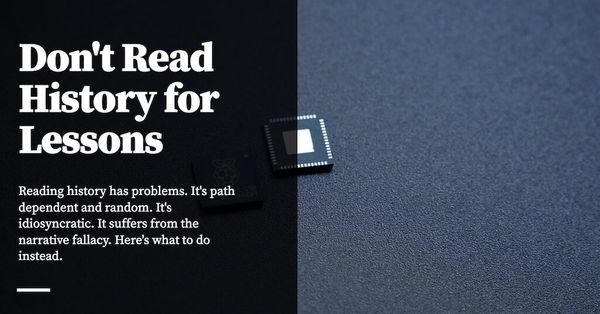Here’s a real world story that you might be familiar with. The question I’d like you to ask while reading it is: what lessons might you take away from it? Keep this question in mind; we’ll return to it in a bit.
In 1958, Morris Chang left his job at Sylvania Semiconductor and joined Texas Instruments as an engineering manager. It was his second job out of college. At the time, TI was growing rapidly, and Chang was assigned a problematic production line for a new germanium transistor for TI’s (then) most important customer — IBM. How problematic? Well, when Chang started on it, the line had a miserable yield of 0%.
Chang spent four months working on the line, eventually getting yields up to 25-30%. This turned out to be twice as good as IBM’s own production line, which meant that the transistor was a huge win — and a very profitable product — for the entire company.
Chang was put on the fast track. TI sponsored a PhD at Stanford, offering to pay his salary for the entire duration of the program. Chang eventually spent two and a half years on his doctorate before returning to TI. Three years later, he was promoted to become general manager of TI’s integrated circuits (IC) department. And there he left a permanent mark on the semiconductor industry.
At the time, the pricing model for ICs was simple. Since semiconductor manufacturing had high capex, manufacturers would charge their customers high prices to recoup their large upfront costs. Chang knew from painful experience that it took a certain amount of fiddling to get yields up — and therefore unit costs down — for every production line. Semiconductor manufacturing was a fickle thing: you had to seek out and remove dust contamination, cycle out or repair defective equipment, identify and work out chemical impurities and so on. Chang had noticed that this fixing process could be sped up if the production line was operating at max capacity, allowing his staff to learn and iterate as fast as possible. The problem was, if TI continued to charge high prices for its semiconductors, customer demand and subsequent production capacity would be limited — slowing down the aforementioned improvement process.
Chang hired a then little-known outfit called the Boston Consulting Group (BCG) to crunch the numbers for him, in order to justify an alternative pricing model. This eventually came to be known as ‘learning curve pricing’ (in Chang’s own words) or ‘experience curve pricing’ (in BCG’s words — BCG co-opted this work and tried to brand it as a BCG-specific thing).
The way it worked was as follows: TI would price their chips way below initial costs, and therefore below prevailing market price. This was considered controversial at the time. As a result, the company would aggressively expand their market share for that particular chip. This high demand meant that production lines could be run at max capacity, driving down the time necessary to bring yields up. The pricing model also had the nice side effect of pressuring competitors to lower their prices, at the risk of losing market share — which many competitors resisted.
TI then went as far as to reduce their prices every quarter, even if their customers didn’t demand it. Chang would later state that his strategy was to “sow despair in the minds of my opponents”. In an interview with Commonwealth Magazine in 2021, Chang said, “In the semiconductor business, we always asked for profit margins in excess of 50% (...) when even Texas Instruments could only achieve a profit margin of 40% by asking the lowest price, they knew they (the competitors) had to get out of the business.”
Learning curve pricing worked because of the nature of semiconductors as a product. Unlike, say, products like personal computers or cars, IC process nodes that were no longer leading edge still found uses in lower-end, cheaper items like microwaves or television sets. So semiconductor manufacturers could run their lines for as long as possible to recoup their initial costs and generate profits — which worked in favour of the manufacturer with the largest market share.
With the learning curve pricing model, TI began to beat everyone else in the semiconductor industry. It eventually became the market leader of the era. On the back of this success, Chang was promoted to VP of the entire semiconductor business — just one level below the CEO. And in 1972, he became the leading candidate to become the next chief executive.
The question, of course, is what to learn from this?
TI began applying learning curve pricing to a whole host of product lines. They applied it, for instance, to the 1972 launch of their personal calculator. Here, the competitors in the calculator market were more determined — leading to a price war and an eventual $16 million loss for TI in Q2 of 1975. Undeterred, TI launched their new electronic digital watch for a mere $19.95 a year later. Again, the low prices allowed TI to capture most of the digital watch market and drive out their higher-priced competitors like Bowmar and Ness Time. When these competitors went bankrupt, TI announced that they were the leading supplier of digital watches, with an annual production of 18 million units. A little more than a year later, TI further lowered the price of the watch to $9.95.

Unfortunately, the logic that underpinned the pricing curve model didn’t seem to map to the consumer products division. TI’s low prices evaporated the already low profit margins in the digital watch division, and stronger competitors learned to follow suit. A race to the bottom had started. In 1978, Commodore introduced an LCD watch with prices starting at $7.95. Chang was transferred from the semiconductor business to become VP of consumer products around the same time.
It may seem a little odd that Chang was transferred from the semiconductor business — one of TI’s most important business units — to consumer products, an underperforming division. The most plausible reason for the transfer was that Chang was passed over for the CEO job. We can never really say for sure why this happened — perhaps it was because he was an immigrant, or perhaps it was because he was ethnically Chinese. Whichever case it was, Chang found himself in the relatively new consumer products division in 1978, with the clear expectation that he would be able to fix it the way he had worked magic with semiconductors the decade before.
Two and half years later, the consumer products division was still underperforming. In his oral history interview, Chang said that the one highlight during his time there was the ‘Speak & Spell’ educational product, which contained the first chip-based speech synthesiser; he called it “the best product that the TI consumer division ever did.” But everything else went pretty horribly.
TI shut down its once-dominant watch division in 1981, due to their failure to anticipate demand for always-on LCD watches and their inability to compete against even lower-priced Asian imports. When consumer demand shifted to LCD watches, TI’s watches went from ‘a distinctive symbol of status to a faceless commodity’. The company was thus saddled with a large and essentially worthless inventory of watches as consumer demand collapsed. When they closed their watch division, almost 3000 employees were laid off.
Chang was moved to a staff job in 1981 — the ‘head of quality and people effectiveness’. He still had a Senior Vice President title, but was effectively put out to pasture. Years later, while reflecting on the move to consumer products, Chang said that the shift was motivated by TI CEO Mark Shepherd’s belief that a good manager could manage anything. In retrospect, Chang said: “I think he was wrong. I found the consumer business to be very different. The customer set — completely different. The market — completely different. And what you need to get ahead in that business is different, too. In the semiconductor business, it’s just technology and costs; in consumer, technology helps, but it’s also the appeal to consumers, which is a nebulous thing.”
Two years later, in 1983, Chang quit. He was a legend in the semiconductor industry, and had accomplished much for TI, but his career had simply hit a dead end. He was 52 years old.
Three years later he would take over the Taiwanese research organisation that he would eventually turn into TSMC — Asia’s most valuable company as of 2022, and certainly one of the most important companies in the world today.
But that’s a story for another time.
The Perils of Learning Lessons from History
What lessons can we learn from Morris Chang’s story?
A few weeks ago, Ben Gilbert and David Rosenthal of the Acquired podcast did an episode summarising all the lessons they’d learnt across 200 episodes of the podcast. They had the following to say about Morris Chang:
David: The other meaning of ‘it's never too late’, folks who are viewing the video here in the auditorium will notice we have not Marc Andreessen on this slide, but Dr. Morris Chang, the founder of TSMC. This is I think the other lesson that I've really taken from Acquired is in this vein, which is that Morris Chang was 56 years old when he founded TSMC. TSMC is today, I believe, the 11th most valuable company in the world. It's so easy. The flip side of the coin of there's always another generation, there's always another wave.
Ben: We should say that it is maybe the thing keeping geopolitical tensions at rest. It may be the force that nobody wants to destabilize, and therefore, we have peace. It's not just a company.
David: But it's easy to think, if you listen to Marc or that there's always another wave, that's for young people. Like it's Steve Jobs, it's Mark Zuckerberg, it's Vitalik Buterin. It's these young kids who get these new waves of technology. The reality is that's just not true. It's just a mindset. You have to be willing to dive in and do it. You can do it at 56 years old and still build the 11th most valuable company in the world (emphasis added).
The problem with this take, of course, is that it’s not entirely true. Sure, Morris Chang did go on to start the 11th most valuable company in the world. But he was also a legend in the semiconductor industry when he left TI. He was a legend because of what he did — he invented learning curve pricing, he led TI to new heights of industry dominance, and throughout his entire career he displayed a special flair for dealing with the nuts and bolts of semiconductor manufacturing. So Chang starting TSMC and turning it into the most valuable company in Asia is a slightly different thing than “oh, you can become super successful even if you’re old if you just take a stab and go after things, so long as you have the right mindset.”
Speaking more generally, though, this has always been the tricky thing about learning from history. History is context dependent. For instance, read the following list of plausible lessons from Morris Chang’s story, and gauge how credible they are:
- Good managers cannot ‘manage anything’. Specialisation counts.
- When you get assigned to save a different department, this may be an opportunity to shine … or a way to get rid of you and put you out to pasture.
- Competitive advantage comes from creation — from discovering things that are under-appreciated by your competitors.
- Learning curve pricing works better when you’re not subject to changing consumer sentiment. (Or perhaps the more general form of this lesson is that scale advantages work better when you’re not subject to abrupt changes in demand).
- Starting a new company in your 50s is ok if you have an edge in your particular field.
You might nod to some of these lessons, and wrinkle your nose at others. But you might be surprised to learn that I don’t think any of these lessons are particularly good. Whenever I read a contrived list of lessons that are drawn from some historical context, I play a game in my head. The game is simple. For every lesson that you see, append “… except when it doesn’t” to the end. So:
- Good managers cannot ‘manage anything’. Specialisation counts … except when it doesn’t.
- When you get assigned to save a different department, this may be an opportunity to shine … or a way to get rid of you and put you out to pasture … except when it’s not either of these things.
- Learning curve pricing works better when you’re not subject to changing consumer sentiment … except when it doesn’t. (Consider: are there examples of other industries where learning curve pricing might work in a more consumer facing product segment?)
- Starting a new company in your 50s is ok — so long as you have a competitive advantage. Except when you do have a competitive advantage, and don’t succeed anyway because you’re too tired for this game and can’t stick it out long enough to win, or the competitive dynamics in your industry don’t allow you to dominate, or a hundred other things that may be variable when you’re building a company that isn’t TSMC.
In fact, the only lesson that I think might pass the “… except when it doesn’t” test is the third one — that competitive advantage comes from creation, since it is true that competitive advantage comes from uncovering things that are undervalued by your competitors.
But my broader point still stands: learning narrow lessons from history is extremely risky because things that are true in one specific context might not be true in a different context — even a slightly different context. This is what the “except when it doesn’t” game uncovers, and it’s what makes learning history so difficult in the first place.
The Age Old Question About Learning From History
Debates about history and historiography are as old as the field of history itself. There are commonly two arguments made against reading history. And there are two common arguments for it.
I think a lot about these arguments, given that I spend a fair bit of time reading business biography. I happen to think that reading history is useful, but a couple hundred books in, I’m also starting to believe that they’re useful in a different way than you might expect.
I’ll begin with the arguments for reading history. These are the kinds of things you’d expect writers of popular history to say, or that you’ll expect to hear from folk who’ve read a great number of books. It is, in fact, an argument that I’ve made, when I wrote The Land And Expand Strategy for Reading; I argued that it was useful to read narrative before getting into the core of a topic.
The first broad argument for reading history is that you’d be able to place current events in their proper historical context. As a recent example, the 2021 US Capitol riots may seem horrible and unprecedented … until you read histories of the American Civil War. (An American friend pointed out to me that things are bad today … but perhaps not as bad as the lead up to the Civil War. And I found I had to agree. I’d read The Metaphysical Club for unrelated reasons a few months before, which covered the lives of four American thinkers as they went through the war, and the ways in which the war influenced their philosophy. The polarisation described in that book was a shock).
Why is this useful? Well, the basic idea is that if you can place current events in their proper context, then you’d be better calibrated to respond to them. The person who has read history would know not to overreact to certain events; the person who hasn’t is seeing everything for the very first time.
There’s an interesting variation of this first argument, one that I first heard in a panel talk by Singapore historian Wang Gungwu — one of the foremost authorities on the Chinese diaspora. Professor Wang argued that history was usually amongst the first things to be weaponised in the event of a war. He gave a number of historical examples, before making the case that a good understanding of history was necessary to resist the narrative machinations of its belligerents. Professor Wang was speaking in the context of a theoretical Sino-Japanese war, but it was clear to everyone present — in Chinese-majority and China-influenced Singapore, stuck right between US-China Great Power relations — that narrative manipulation was something to be reckoned with, from both powers, in the near-future.
Professor Wang then framed the rest of his talk by saying that ‘historians may make predictions “just for fun” to see if things could have been done a different way. “Unfortunately,” he added, “there are many, many examples I can think of where we don’t learn [from history]”.’
Wang’s frame — and the underlying assumptions behind that last statement — leads us to a second argument. There is a widespread belief that reading history will allow you to ‘learn the lessons of history’. The strong form of this argument goes something like “if you read history, you’ll learn important things … like not to fight a land war in Asia, or not to invade Russia during the winter.” The practical way this argument expresses itself is in the belief, say, that the Fall of Rome occurred for a dozen proximate reasons; that historians uncover new reasons as the decades pass, and that if you read enough of these books and pore over enough of these lessons you may triangulate towards something close to the truth. If you get to this truth, the argument goes, you will be able to ‘avoid the mistakes of your forebears.’
This form of the argument is considered ‘strong’ because it assumes you can apply the lessons directly. On the face of it, this is a pretty remarkable claim, since the lessons of Ancient Rome may seem a little removed from the modern nation states of today.
In response, some folk back into the weak form of the argument. The weak form is what you get when you hear someone say “history doesn’t repeat itself, but it rhymes” — that is, perhaps the lessons of history are too specific to a particular context to generalise, but that some … similarity is consistent over time. I have some sympathy for this view — after all, if you read ten histories of an industry and find that the companies within it all succeed or fail in broadly similar ways, then perhaps there is some information there that is worth taking away with you.
The underlying assumption behind both the strong and the weak forms of this argument is that you can learn lessons from history. And to make things clear, I think this is true. I just don’t think the lessons are anything like what we think lessons should look like.
The reason I think this way is because I’m sympathetic to the two criticisms most typically levelled against learning from history. To summarise crudely, the two arguments go something like:
- Everything in life is path dependent. A lucky break early in a person’s career makes all their latter successes easier; a lucky decision early on in a company’s life makes their latter projects more likely to succeed. You can’t replicate a company’s success, nor learn from their failures, if you don’t also replicate their path. And it is impossible to replicate their path. As a throwaway example, think back to the legendary, non-exclusive deal IBM made with Microsoft for MS-DOS in 1980 — which allowed Microsoft to sell DOS to every other PC-compatible manufacturer. This deal is often described as “IBM’s great mistake”. Had they not done the deal, Microsoft would have had a very different set of opportunities in the ensuing decade. But IBM did do the deal with Microsoft, and that, in turn, set the stage for Microsoft’s dominance in operating systems for years afterwards. It may not be useful to learn the lessons of Microsoft’s history when much of what they accomplished hinged on chance events and idiosyncratic decisions in their past.
- The second argument against reading history is even more harsh. The argument is that accountings of history are not accurate, and can never be accurate, thanks to the narrative fallacy. By its nature, narrative necessarily compresses reality into some coherent tale, meaning that accountings of history tend to overemphasise intention and action, instead of the more plausible ‘random actions by actors in a complex adaptive system, conspiring to create unexpected results’. This is a roundabout way of saying that whatever histories you read are most likely wrong — and not even a good representation of reality.
The real trick of reading history, it seems to me, is to find a way to read for things that are idempotent across time. You ideally want ideas or takeaways that generalise properly.
It’s just a pity that it’s so hard to do so.
How to Read History?
So: alright, you might think. Give it to me. How do you propose we read history?
In a sentence: I think we should read history for concept instantiations, not lessons.
Longtime readers would know this is an idea that falls out of Cognitive Flexibility Theory, a theory of adaptive expertise in ill-structured domains, which I’ve covered multiple times over the past few months. But what does this actually mean? What does it actually look like when you’re reading history for concept instantiations, instead of narrow, context-constrained lessons?
Well, consider the following set of ‘lessons’:
- Learning economies work by increasing production volume in order to drive down costs. The TI story is the story of its discovery — or more specifically, the story of how it came to be weaponised as a competitive advantage. In other words, this is an example of what learning economies looks like when employed as a competitive strategy.
- In 7 Powers Hamilton Helmer asserts that all competitive advantage comes from invention. Chang’s story at TI is an example of what that looks like in practice.
- You may be put out to pasture for weird political reasons, and this is one way that can happen. But, more importantly —
- Morris Chang went to MIT, finished his PhD at Stanford in two-and-a-half years, invented learning curve pricing (which is still used in the semiconductor industry today), and in the process led an entire company division to market leadership, over the course of 25 years at Texas Instruments. He was still put out to pasture at age 52. So if it can happen to him, it shouldn’t be too surprising if it happens to you. By which I mean: you shouldn’t be too shocked if you find yourself in a similar situation; Chang’s story tells you that getting dumped after a long, successful career is within the span of plausible career outcomes — you know this because it’s happened before.
What makes these ‘lessons’ different from the ones I talked about earlier?
For starters, notice that each of the ‘lessons’ are structured as “this is a real world example of some concept or idea”, instead of a more general “you should do X” or “when Y happens, you should watch out for Z”. Structuring lessons in this ‘concept instantiation’ form makes them more constrained, but also more useful. They are more useful because they allow you to recognise similar situations as they occur to you in your life — in other words, the form teaches you to see, without forcing you into narrow, actionable recommendations.
The truth is that generalisable lessons of the form “you should do X” tend to fall flat when applied to real world situations — because the situations you’ll encounter will always be different from the situations you read about in history. There’s an even worse tendency that I’ve noticed, where people read a little history and then attempt to turn it into a coherent framework in their heads. The failure mode is that the framework then acts as a blinker — it slows down their learning, and blinds them to other cases that might not fit into the neat structure they’ve spuriously drawn up to guide their actions.
I’m coming around to the idea that you should not bother with generalisable lessons — or at least, to be extremely conservative when you attempt to do so. Instead, you want to think “ok, this is an instance of <concept>, and this is one additional way this can show up in the real world.” To reiterate one of the central claims of CFT: experts in ill-structured domains reason by comparison to fragments from prior cases they’ve seen — one implication is that concepts are represented not as abstract principles in their heads, but a cluster of real world cases that serve as prototypes.
The goal of reading from history, then, is to expand the set of prototypes in your head.
Treating history in this manner sidesteps many of the problems we’ve discussed earlier. You don’t have to worry about path dependence, for instance, since you’re not drawing tight lessons from specific scenarios. Nor do you have to care as much about the narrative fallacy — if you have enough samples of the thing in action, your brain will be able to pattern match against the similarities across cases, never you mind that retellings of each case may be inherently flawed. When you’re hunting for concept instantiations, the criticisms of historiography are a wash; they fall to the wayside.
Let’s return to Morris Chang’s story. One of the biggest ‘lessons’ I took away from the entire first arc of his career is that “oh, this is what the bamboo ceiling looks like”. I bring this up not because it is applicable to me — I am an Asian of Chinese descent, but I am not based in the US; Asians in Asia do not face a bamboo ceiling the way that Asian Americans might. Instead, I bring this up because I want to map it to an experience that I think all of us might have had.
How many times have you had an experience where you then say, perhaps to a friend, perhaps over drinks: “oh, I always knew X (e.g. ‘the bamboo ceiling’) was a thing, but I never really thought deeply about it until it happened to me.”
To which the person you’re talking to goes, “Oh yeah, that can happen. Have you heard about what happened to Bob?”
“No, what happened?”
“Well, arguably his story is crazier than yours ...”
And then you go on to listen to some narrative about Bob, and you file it away in your head, next to your own personal experience of the thing.
I bring this up because this is what learning from concept instantiation looks like. The only difference is that, when you read case studies with intentionality, you’re not waiting for something to hit you over the head, and you’re not reliant on your friends to tell you about actual cases that have happened to them or to people they know.
Instead, you’re drawing from the collective experience of people you don’t know, doing things you can’t imagine, across the entire arc of time.
You are, in effect, learning from history.
Originally published , last updated .
This article is part of the Expertise Acceleration topic cluster. Read more from this topic here→





